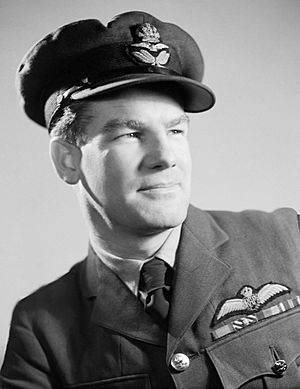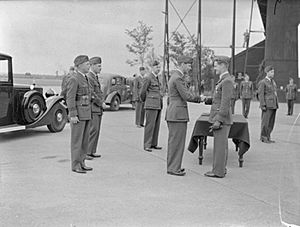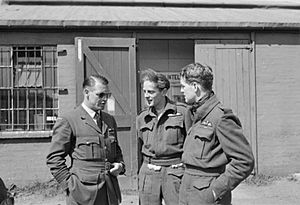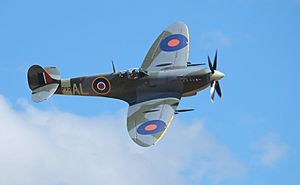Alan Deere facts for kids
Quick facts for kids
Alan Deere
|
|
|---|---|

Alan Deere, July 1944
|
|
| Birth name | Alan Christoper Deere |
| Nickname(s) | Al |
| Born | 12 December 1917 Westport, New Zealand |
| Died | 21 September 1995 (aged 77) United Kingdom |
| Allegiance | United Kingdom British Empire |
| Service/ |
Royal Air Force |
| Years of service | 1937–1967 |
| Rank | Air Commodore |
| Unit | No. 54 Squadron |
| Commands held | No. 602 Squadron No. 403 Squadron RCAF Biggin Hill Wing RAF Duxford RAF North Weald 12 (East Anglia) Sector, Fighter Command No. 1 School of Technical Training |
| Battles/wars | Second World War |
| Awards | Distinguished Service Order Officer of the Order of the British Empire Distinguished Flying Cross & Bar Croix de Guerre (France) Distinguished Flying Cross (United States) |
| Other work | Author |
Air Commodore Alan Christopher Deere (1917–1995) was a brave New Zealand fighter ace. He flew for the Royal Air Force (RAF) during the Second World War. Alan Deere was famous for surviving many dangerous situations during the war. Because of this, his book about his life was called Nine Lives.
Born in Westport, New Zealand, in 1917, Deere joined the RAF in 1938. He flew Supermarine Spitfire planes with No. 54 Squadron. He became a fighter ace during the Battle of France in May 1940. A fighter ace is a pilot who shoots down five or more enemy aircraft. He received the Distinguished Flying Cross (DFC) for his bravery.
He also fought in the Battle of Britain, shooting down more enemy planes. His Spitfire was destroyed several times, but he always survived. He earned another award, a bar to his DFC, in September 1940. He became a squadron leader and later led No. 403 Squadron RCAF in 1942. In 1943, he led a group of fighters from Biggin Hill. He received the Distinguished Service Order for his leadership.
By the end of the war, he was one of New Zealand's top fighter aces. He was credited with shooting down 22 enemy aircraft. Later studies changed this number to 17 victories. Deere stayed in the RAF after the war, becoming an Air Commodore. He wrote his autobiography, Nine Lives, in 1959. He retired from the military in 1967 and worked for the RAF as a sports director. Alan Deere passed away in 1995.
Contents
Early Life and Dream of Flying
Alan Christopher Deere was born in Westport, New Zealand, on December 12, 1917. He was one of six children. His family moved to Wanganui in 1930. Alan was a great athlete, playing rugby, cricket, and boxing. He was also good at school.
In 1933, a famous pilot named Sir Charles Kingsford Smith visited Wanganui. He offered paid flights in his plane, the Southern Cross. Alan took a flight and decided he wanted to be a pilot. After school, he worked on a sheep farm and then as a law clerk.
In 1936, Alan learned that the Royal Air Force (RAF) was accepting pilots from New Zealand. His father did not want him to join, but his mother signed the application form. Alan passed the tests in 1937 and sailed to England to start his training.
Becoming an RAF Pilot
Alan arrived in London in October 1937 and began flight training. He had a small medical issue with high blood pressure, but he passed later tests. Doctors said it was just excitement about flying.
Deere's training went well. He flew alone for the first time in a de Havilland Tiger Moth in November 1937. In January 1938, he officially became an acting pilot officer. He then went to officer training. Alan was chosen for the RAF boxing team, but he chose to focus on flying instead. The plane carrying the boxing team crashed, and some people died.
In May 1938, Alan earned his pilot's "wings." He was chosen for RAF Fighter Command. He first flew Hawker Fury biplane fighters. Three months later, he joined No. 54 Squadron at Hornchurch. His squadron flew Gloster Gladiator planes.
In early 1939, No. 54 Squadron started flying Supermarine Spitfires. Alan loved the Spitfire, calling it "marvellous." Once, he blacked out while flying high. He recovered just in time to pull his Spitfire out of a dive. He learned that one of his eardrums had burst because he forgot to use enough oxygen. He could not fly until he recovered.
Second World War Hero
When the Second World War began, No. 54 Squadron flew patrols. They protected ships and looked for German planes. They were involved in a "friendly fire" incident where two British planes were shot down by mistake. Alan noticed that ground controllers needed to give clearer directions to pilots.
Battle of France: First Victories
The Battle of France started in May 1940. British forces were retreating to Dunkirk. From May 16, No. 54 Squadron helped protect the Allied troops. Alan flew many patrols over the English Channel to Dunkirk.
On May 23, Alan scored his first victories. He was escorting a trainer plane to rescue a pilot near Calais. He shot down two Messerschmitt Bf 109 fighters. He damaged a third but ran out of bullets. He had to return to England. This mission showed Alan how tough the Bf 109 was. He thought the Spitfire could turn better, but the Bf 109 was faster when diving.
The next day, Alan shot down another Bf 109. On May 26, he shot down two Messerschmitt Me 110 heavy fighters. His plane was badly damaged, with part of a wing shot away.
Operation Dynamo was the plan to evacuate British troops from Dunkirk. The RAF protected the ships. On May 27, Alan destroyed a Junkers Ju 88 bomber. The next day, his Spitfire was damaged by a German bomber's machine-gun fire. He had to make an emergency landing on a Belgian beach. He was knocked out. After waking up, he walked to a town, got his head injuries treated, and hitched a ride to Dunkirk. He then took a boat to Dover and returned to Hornchurch.
No. 54 Squadron moved to RAF Catterick for a rest. They had lost many pilots and planes. They returned to Hornchurch in June 1940 with new Spitfires. Later that month, Alan was awarded the Distinguished Flying Cross (DFC). King George VI presented it to him at Hornchurch on June 27.
On July 9, Alan shot down a Bf 109. But he collided with another Bf 109. His Spitfire's propeller was bent, the engine stopped, and the tail was damaged. He glided to a forced landing in a field. He escaped his burning plane just before it was destroyed. He returned to Hornchurch the next day.
Battle of Britain: Surviving Again and Again
The Battle of Britain began on July 10, 1940. The German air force, the Luftwaffe, attacked England's coast and ships. They wanted to destroy the RAF to prepare for an invasion. Alan's squadron was heavily involved.
On July 24, Alan destroyed a Bf 109. This was his first victory of the Battle of Britain. A few days later, he was promoted to flying officer. His squadron, having flown more missions than any other, was sent to Catterick for a rest.
No. 54 Squadron returned to Hornchurch on August 8. On August 12, Alan shot down a Bf 109 and an Me 110. On August 15, he destroyed another Bf 109. Later that day, he shot down two more Bf 109s over the English Channel. His Spitfire was badly damaged, with its engine on fire. He bailed out at a low height. He hit the tail of his plane and hurt his wrist. He was back flying on August 17. Soon after, Winston Churchill gave his famous "The Few" speech about the RAF pilots. Alan joked, "he can say that again. There aren't many of us left."
On August 28, Alan was shot down again, this time by a friendly Spitfire. He parachuted to safety. He later said the "strain had almost reached breaking point." On August 31, the Luftwaffe bombed Hornchurch. Alan's Spitfire was destroyed on the runway, trapping him. He was pulled out with a scalp injury. He was told to rest but started flying again on September 2. The squadron then moved back to Catterick for a much-needed rest.
Soon after, Alan received a bar to his DFC for his continued bravery.
Leading Squadrons and Wings
In 1941, Alan became an acting squadron leader. He worked as an operations room controller. He soon wanted to fly again. In May 1941, he joined No. 602 Squadron in Scotland. He was a flight commander.
Alan was already famous for his narrow escapes. On one flight, his Spitfire's engine failed. He crash-landed in a potato field, flipping his plane over. He managed to get free. In July, his rank of flight lieutenant became permanent. He temporarily led No. 602 Squadron and shot down another Bf 109.
In January 1942, Alan went on a trip to America to lecture. He taught American pilots about fighter tactics. After six weeks, he returned to England. He was given command of No. 403 Squadron of the Royal Canadian Air Force. The squadron's morale was low due to losses. Alan quickly brought them back to fighting shape.
On June 2, his squadron faced 40 to 50 Focke-Wulf Fw 190 fighters. Half of his 12 planes were lost. Alan used all his ammunition but could not confirm any kills. He felt his aggressive leadership was blamed for the losses.
In early 1943, Alan returned to flying. He shot down an Fw 190 on February 16. He was then given command of the fighter wing at Biggin Hill. He was also promoted to wing commander.
Wing Leader at Biggin Hill
At Biggin Hill, Alan worked with Sailor Malan, the station's commander. Alan taught his pilots new tactics for escorting bombers into France. He stressed that fighters should not be tied too closely to the bombers' speed. His first mission as wing leader was on April 4, 1943.
In June, Alan damaged an Fw 190 during a big fight with 50 German fighters. On June 23, he destroyed another Fw 190. In July, No. 485 Squadron, with many New Zealand pilots, joined his wing. Alan had recommended its commander, Johnny Checketts. On July 14, Alan shot down another Fw 190.
By late September 1943, Alan was very tired and had been ill. He had lost close friends. Malan gave him leave. For his leadership, Alan received the Distinguished Flying Cross from the United States. In November, he received the DSO award at Buckingham Palace.
Later War Service
In March 1944, Alan joined the headquarters of No. 11 Group. He also received the Croix de Guerre from the French forces. On May 1, he took command of No. 145 Wing, which included two French squadrons. This wing provided air cover over the beaches on D-Day. Alan moved with his wing to France. In July, he joined No. 84 Group, helping to call in air strikes for ground forces. When the war in Europe ended in May 1945, he was in Germany.
Alan Deere was one of New Zealand's most famous fighter pilots. He was credited with 17 enemy aircraft destroyed, plus others damaged. He was second only to Colin Gray among New Zealand aces.
Post-War Career and Retirement
In July 1945, Alan led a Polish P-51 Mustang wing. In October, he became commanding officer of RAF Duxford. He also received a permanent commission as a squadron leader in the RAF. At the end of 1945, he was appointed to the Order of the British Empire for his service.
In August 1946, Alan took a course on air strategy in America. He then worked in Malta for two years. He returned to the United Kingdom in 1949. His rank of wing commander became permanent in 1951. He then worked at Fighter Command's No. 11 Group.
Alan returned to his old wartime base, RAF North Weald, in May 1952 as station commander. He continued to fly Gloster Meteor jets. In 1954, he moved to Germany. From 1957, he taught at the RAF Staff College. Later that year, he was promoted to group captain.
While teaching, Alan wrote his autobiography, Nine Lives. It was published in 1959 and received good reviews. The book's title referred to his many close calls during the war.
In 1961, Alan was appointed aide-de-camp to Queen Elizabeth II. He led Fighter Command's East Anglia sector. In July 1964, he was promoted to air commodore. On January 30, 1965, he had the honor of leading Battle of Britain pilots in the funeral procession for Winston Churchill. He retired from the RAF on December 12, 1967.
Later Life and Legacy
After retiring, Alan immediately became the RAF's Director of Sport. He held this role until 1972. He also chaired the RAF Rugby Committee. In 1972, he appeared on a TV show called This Is Your Life for Douglas Bader. Alan told the story of flying to deliver a replacement leg for Bader, who was a prisoner of war. In 1990, he was on the New Zealand version of the show for his friend Johnny Checketts. This was Alan's last visit to New Zealand.
As a famous Spitfire pilot, Alan was often asked by historians for his stories. His book Nine Lives was republished in 1991. He was also interviewed for a documentary about New Zealand in the Second World War. In his later years, he suffered from cancer. He passed away on September 21, 1995, at age 77. He was cremated, and his ashes were scattered over the River Thames from a Spitfire. He was survived by his wife, Joan, and their two children.
Alan Deere's medals are at the RAF Museum at Hendon. His original book manuscript is also there. Other items are displayed in the Hornchurch Wing Collection in Purfleet, Essex. The engine of the Spitfire he crashed on August 28, 1940, is at the Kent Battle of Britain Museum. In New Zealand, the Air Force Museum of New Zealand has one of his boxing trophies. Alan's nephew, Brendon Deere, restored a Spitfire Mk IX. This plane now has the markings of Alan's aircraft from his time at Biggin Hill.






